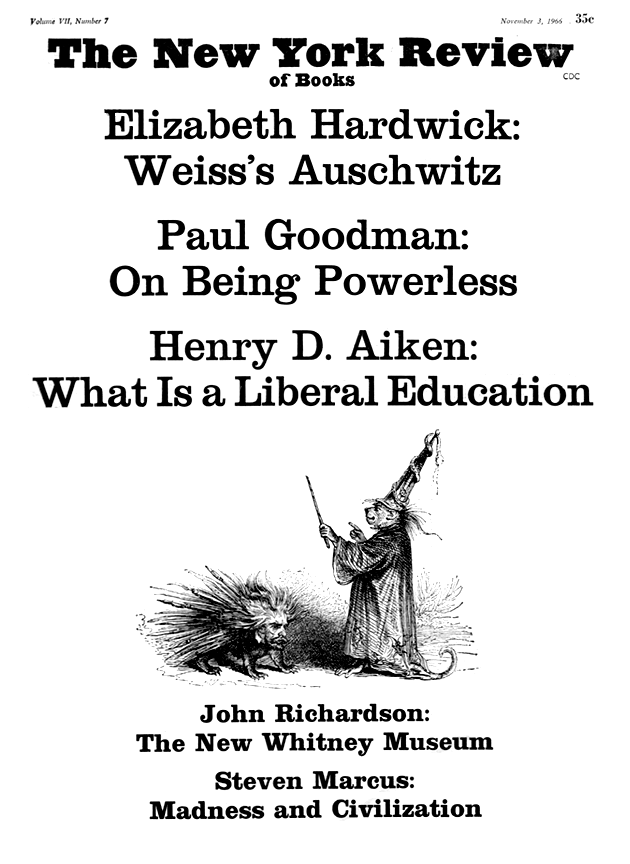In response to:
Hawthorne in Analysis from the September 22, 1966 issue
To the Editors:
Mr. Philip Rahv’s literary comment is usually distinguished by a strong sense of history and society. It is a shock, therefore, to see him so uncritically enthusiastic about the good news of a Freudian analysis of Hawthorne and his work [NYR Sept. 23]. His irritation with the neo-orthodox image of Hawthorne is understandable, but he seems to be in the mood of reaching for any stick to beat a dog. Of course, as Constance Rourke, a pioneer in American Studies scholarship, pointed out in 1927: “Some of Hawthorne’s tales rested upon the great questions which had shaken New England, questions as to the nature and results of sin, and the final human destiny; but Hawthorne had penetrated far beneath the incidence of doctrine to these typical strata of mental and moral compulsion, to those tenser bases of personality, which may generate the springs of controversy but which underlie such matters, belonging to the elementary in the human character.” (Trumpets of Jubilee)
It is ironic that while psychiatry is becoming increasingly concerned about relating private troubles to larger social issues, Mr. Rahv is so excited about relating Hawthorne’s stories to the vicissitudes of his libido. Fantasies of incest and parricide, after all, are not the only sources of ambivalence, Hawthorne’s ambivalence about the dark lady of The Marble Faun has an important relation to his ambivalence about Europe. Dr. Grimshawe’s Secret does indeed, if I may quote myself, vibrate “with all the ambivalence of a dream told in the psychoanalyst’s office,” but its content has much to do with the strained piety of an old-Yankee self-critical Democrat, exploring “Our Old Home.”
The casualty of a Freudian reading of Hawthorne is his manifest content. The Scarlet Letter, as Benjamin DeMott has forcefully argued, grew out of Hawthorne’s fascination with the idea of a man (like Dimmesdale) whose reputation rested on baseless credit, “making the whole universe, heaven and earth alike, an unsubstantial mockery to him.” This contrast between the private self and the public self is a theme which takes seriously the reality of the idea of society and one’s position in it. Are we so bereft of historical sense that we cannot imagine how a nineteenth-century writer could take that idea seriously? It is astonishing that Mr. Rahv, of all people, should provoke this question.
Cushing Strout
Ithaca, New York
Philip Rahv replies:
As a literary critic I am the last one to denigrate the historical sense or the idea of society as factors that rightly enter literary judgement. Nor am I in any sense a partisan of the Freudian “method,” as Mr. Strout insinuates. I have always rejected the exclusivistic claims of “methodology,” of whatever kind, whenever such claims get in the way of the proper function of literary criticism and scholarship. It seemed to me that Professor Crews, in applying Freudian theory to Hawthorne, demonstrated its appropriateness to his particular case; that is why I praised the book. In the case of a great many other writers the theory might prove to be without heuristic value. In other words, it is not the “method” as such but its suitability to a given subject that makes for relevance and the rewards of discovery.
What I chiefly protested against in my review is the use of historical documentation—something quite different from “the historical sense”—and, above all, the use of neo-orthodox notions as a means of both depersonalizing Hawthorne’s fiction and backing away from any realistic investigation of his temperament, private background, and psychic disposition. And it is precisely my historical sense that tells me that Hawthorne’s religiosity was not a matter of the deepest personal feeling or belief but, as I wrote in my review, no more than a traditional rhetoric he adopted as a protective screen for his fantasies, which his contemporaries would have rejected as indecent had they been able to penetrate them. I am not in the least impressed by the quotation from the late Constance Rourke, a pioneer in American Studies, who, in my opinion, regularly dissolved the individual and literary qualities of American authors in a kind of festive and all-too-flattering conception of the American ethos. Her books are not without value, but I regret to say that the approach of which she was one of the initiators has nowadays become far more popular than it deserves to be. It goes without saying that all American writing is in some ways expressive of the national spirit and of national characteristics, but that cannot mean that a mere rehearsal of such characteristics, real or imaginary, can possibly serve as a substitute for understanding works of art or that it should delimit our analysis of them. The Americanness of American literature is in a certain sense a tautology in which many of our scholars and critics have now lost themselves. It is one more evasion, a highly subsidized, institutionalized evasion, of the task of criticism.
As for Hawthorne’s ambivalence towards his dark lady in The Marble Faun, I cannot agree with Mr. Strout that it is related significantly to his “ambivalence about Europe.” The latter attitude, predictable and commonplace, he shared with a good many Americans, but his ambivalence towards the dark lady—a figure of his imagination—is already obvious in works that precede by a number of years his travels in Europe. Miriam of The Marble Faun is substantially the same character-image as Hester in The Scarlet Letter and Zenobia in The Blithedale Romance, and these works have nothing whatever to do with Hawthorne’s impressions of Europe in later years.
This Issue
November 3, 1966


